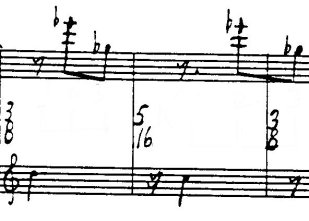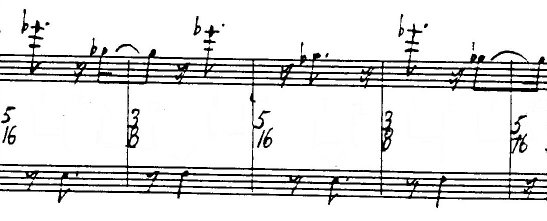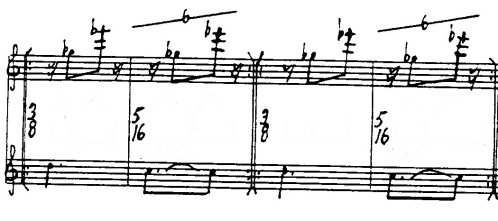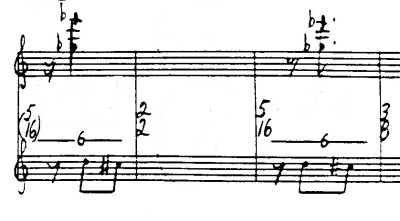After I learned the first seven pages of For Bunita Marcus, I allowed myself to continue to the next chunk of music. Pages 8-10 are almost completely taken up with the same image made up of two oscillations: an E-flat and G-flat in the right hand, and a C and D in the left:
Feldman plays with this pattern for the next four minutes of the score; I’ll go ahead and do the play-by-play here. He opens with the eighth-note pattern above, and over the next ten bars or so he moves the patterns around rhythmically so that the left hand notes move out of phase with the right hand, and the overall length of the pattern expands and contracts subtly. Following this, the left-hand/right-hand pattern changes: the two notes in the right hand settle into a slower, straight quarter-note rhythm, while the notes in the left hand continue as before. This causes a fundamental change in the image, from a three-note phrase to a series of two note phrases:
The quarter-note pulse disappears, but the two-note phrases continue, spreading out and becoming more sparse. At the top of page 9, the three-note arrangement returns, but with a change in direction in the right hand:
The sextuplet over 5/16 boggles the mind, but I approach this as a written-out tempo change and just play the 5/16 bars “a little too fast.” Page 9 then rings more changes on the patterns of page 8, again slowing down and spreading out by the end of the page. The top of page 10 announces a different formulation of the same basic sonority, changing the C to a C-sharp and combining the notes in the right hand:
The shifting rhythmic patterns return after this, but with the notes in the right hand moving chromatically within the range of C to E-flat before settling on C-sharp and D. Finally, at the end of page 10, Feldman puts this image aside.
First, let me say that this section is a nightmare to count. With the exception of the top of page 10, all of this music uses alternating bars of 3/8 and 5/16, but the patterns themselves have no alignment with the barlines. This, plus the irregularity of Feldman’s manuscript, make the score almost impossible to read. I’ve made up counts of two to four eighth notes and marked them in the score throughout so that I can count and keep track of where I am, and where the notes come relative to an eighth-note pulse. Here’s a before-and-after of the score to give you an idea of how I’m doing it:
Preparing the score in this manner feels a little bit like doing math homework, but it’s helped me bring this section under control. The main difficulty now is keeping it even and calm, even while I count furiously under my breath. It should float for four minutes and not sound mechanical.
In an earlier posting, I made the case that what Feldman does with his images isn’t just repetition and that it doesn’t really belong stylistically with classic minimalism. But the lack of pauses here, the basic eighth-note pulse, and the shifting, almost hocketing patterns of pages 8-10 make me see how you could make that argument. But there’s nothing motoric about the patterns here: they have too many gaps and irregularities in them, they clump together and thin out. And ultimately we don’t really get anywhere, although the meandering chromatic line in the left hand at the end suggests some kind of discovery. It feels a bit like a cop-out to say that this is just four minutes of a particular color wash, but perhaps that is indeed what’s going on here. I keep having to remind myself that we’re only about a third of the way through and there’s no telling what will come next.







I think you could learn a lot about this piece by looking at the work of the the person it is dedicated to. The dedication is not there just for decoration.
I wouldn’t consider this material “phrases:” “This causes a fundamental change in the image, from a three-note phrase to a series of two note phrases:” They are really pitches stuck in a certain register. Follow the register and see what you get. Connect the pitches in a certain register together and maintain the registers, do not group the pitches into Images across registers. This is not what is happening here. Each register is a voice.
Also later you change the counting but seem to ignore the barline. The barline is essential to the touch and interpretation of the pitch. Just count sixteenth notes in groups of 1s, 2s and 3s. And if you count it correctly you will get somewhere because the fundamental pitch shifts in these sections. It’s like a modulation that results from altering the downbeat. After you’ve counted the 16th notes throughout the piece a few hundred times with a metronome, then try it without counting, sort of by memory. Things will start falling in place.
Somewhere you wonder what to do with your hands during the 2/2 rest. Always move immediately to the next chord and have your fingers in place long before you actually press the keys. This is also improve your touch. And touch is essential to interpreting Feldman.
Good luck, no charge for the lesson, although I am available for coaching: http://www.bunitamarcus.com/teaching.html
Also once you get the basic mechanics of the rhythm and pitches out of the way, I would encourage you to “orchestrate” the piano (especially by registers).
Best of luck James, hope this helps.
Bunita
Thanks for your insights; that totally changes the way I’m hearing that part of the piece. If I’m understanding you correctly, the whole passage on pages 8-10 is essentially a single sustained sonority, sustained by this network of individual attacks. I am reminded of that long sustained choral sound in Rothko Chapel, where all the breath points are written out and staggered. This creates a sound that is simultaneously vertical and horizontal: there is the one sustained harmony, but there is an activity, an articulation, an activation of that harmony that takes place in time.
I personally find it difficult to hear it that way, I think, because the rhythms here are so compelling, it makes me focus on the patterning and not the overall sonority. I think that this shifting between horizontal and vertical is an important part of this music, something I need to pay more attention to.
Yes it is a single sustained passage, I don’t know if I would call it a sonority, but maybe it is. Yet my point remains that you should play through each register by itself and listen only to a register at a time. You will see there are things happening in the registers on the horizontal. Then when you play the piece listen again to the registers and try to connect the notes in one register. So you would have three melodies, one in each register, going on at the same time. In order to bring this about you must listen to the registers separately and usually orchestrate the touch of each register differently. For example, I would always use two fingers on the highest note to bring it out, rather than trying to play it louder with one finger. The weight of the two fingers takes care of this problem.
Then there are the barlines to consider . . . .
I think that I see what you are saying. The challenging thing will be to hear what you are saying! I took a quick spin through this last night and I have my work cut out for me. I’m going to woodshed this a bit and probably devote a future post to this once I have the time to make some headway on this passage. Thanks again for the pointers.